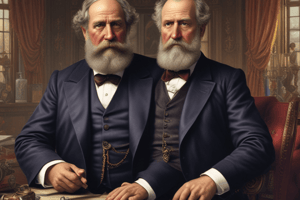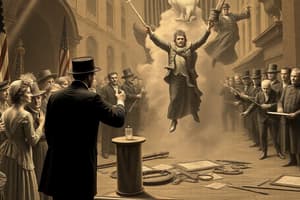Podcast
Questions and Answers
What does 'waving the bloody shirt' refer to?
What does 'waving the bloody shirt' refer to?
- A form of protest
- The use of Civil War imagery by Republicans (correct)
- The use of Civil War imagery by Democrats
- A method of voting
What was the Tweed Ring?
What was the Tweed Ring?
A symbol of Gilded Age corruption led by 'Boss' Tweed.
What was the Crédit Mobilier scandal?
What was the Crédit Mobilier scandal?
A construction company formed to inflate railroad contracts and bribe officials.
What triggered the Panic of 1873?
What triggered the Panic of 1873?
What does the term 'Gilded Age' refer to?
What does the term 'Gilded Age' refer to?
What is patronage?
What is patronage?
What was the Compromise of 1877?
What was the Compromise of 1877?
What did the Civil Rights Act of 1875 promise?
What did the Civil Rights Act of 1875 promise?
What is sharecropping?
What is sharecropping?
What was the Chinese Exclusion Act?
What was the Chinese Exclusion Act?
What did the Supreme Court case Plessy v. Ferguson uphold?
What did the Supreme Court case Plessy v. Ferguson uphold?
What did the Pendleton Act establish?
What did the Pendleton Act establish?
What was Jim Crow?
What was Jim Crow?
What was the Homestead Strike?
What was the Homestead Strike?
What was the grandfather clause?
What was the grandfather clause?
Who was Jay Gould?
Who was Jay Gould?
Who was Horace Greeley?
Who was Horace Greeley?
What was Rutherford B. Hayes known for?
What was Rutherford B. Hayes known for?
Who was James Garfield?
Who was James Garfield?
Who was Chester Arthur?
Who was Chester Arthur?
Who was Grover Cleveland?
Who was Grover Cleveland?
Who was Thomas Reed?
Who was Thomas Reed?
Who was Tom Watson?
Who was Tom Watson?
Who was William Jennings Bryan?
Who was William Jennings Bryan?
Who was J. P. Morgan?
Who was J. P. Morgan?
Flashcards are hidden until you start studying
Study Notes
Gilded Age and Political Corruption
- "Waving the bloody shirt" was a tactic used by Republicans to invoke Civil War imagery to secure votes for Grant.
- The Tweed Ring epitomized Gilded Age corruption, orchestrated by "Boss" Tweed, who embezzled $200 million from New York City through bribery and graft.
- The Crédit Mobilier scandal involved a company linked to Union Pacific Railroad that grossly inflated contract prices, leading to bribery of congressmen in 1872.
Economic Crises and Reforms
- The Panic of 1873 triggered a global depression, beginning with a major bank's bankruptcy, resulting in widespread financial collapse.
- Calls for inflationary measures increased during the Panic, influencing late 19th-century politics and economic policies.
- Patronage emerged as a practice of offering government jobs based on political support rather than merit, notably supported by the Republican Stalwart faction.
Civil Rights and Reconstruction
- The Compromise of 1877 resolved the disputed 1876 election, resulting in Rutherford B. Hayes' presidency and the withdrawal of federal troops, marking the end of Reconstruction.
- The Civil Rights Act of 1875 aimed to ensure equal access for blacks to public accommodations but lacked enforcement mechanisms and was largely ineffective.
Racial Dynamics and Legislation
- Sharecropping entrenched economic dependency, where farmers rented land from landowners, leading to perpetual debt for many, particularly blacks.
- The Chinese Exclusion Act represented the first significant legal restriction on immigration, specifically targeting Chinese newcomers.
- The Plessy v. Ferguson case established "separate but equal" as a legal doctrine for segregation, legitimizing the Jim Crow laws until the 1950s.
Labor Movements and Strikes
- The Homestead Strike of 1892 involved significant violence between steelworkers and hired detectives, contributing to the rise of labor movements.
Political Influences and Key Figures
- The Pendleton Act reformulated the spoils system, mandating that federal jobs be awarded based on merit through examinations.
- Jim Crow laws enforced racial segregation in the South, prevailing through custom and violence from the end of Reconstruction until the mid-20th century.
- Grandfather clauses allowed many whites to bypass voting restrictions while disenfranchising blacks, ensuring white political control.
- Jay Gould was a notorious speculator who manipulated the gold market, significantly impacting the economy.
- Horace Greeley was an influential editor who was nominated for president by the Liberal Republican Party in 1872.
- Rutherford B. Hayes won the contentious 1876 election and was pivotal in ending military involvement in the South.
- James Garfield’s presidency, cut short by assassination, led to significant reforms, including the Pendleton Act, under Chester Arthur’s leadership.
- Grover Cleveland, the 22nd president, was known for his honesty and laissez-faire approach, famously vetoing unnecessary pension bills.
- Thomas Reed, as Speaker of the House, exercised authoritarian control over legislation during the Republican dominance.
Notable Political Movements and Figures
- Tom Watson initially promoted black rights within the Populist movement but shifted to an openly racist stance over time.
- William Jennings Bryan emerged as a prominent advocate for "free silver," championing the cause in the early 1890s.
- J.P. Morgan, a powerful banker, elicited public outrage over his covert financial rescue of the federal government in 1895.
Studying That Suits You
Use AI to generate personalized quizzes and flashcards to suit your learning preferences.




